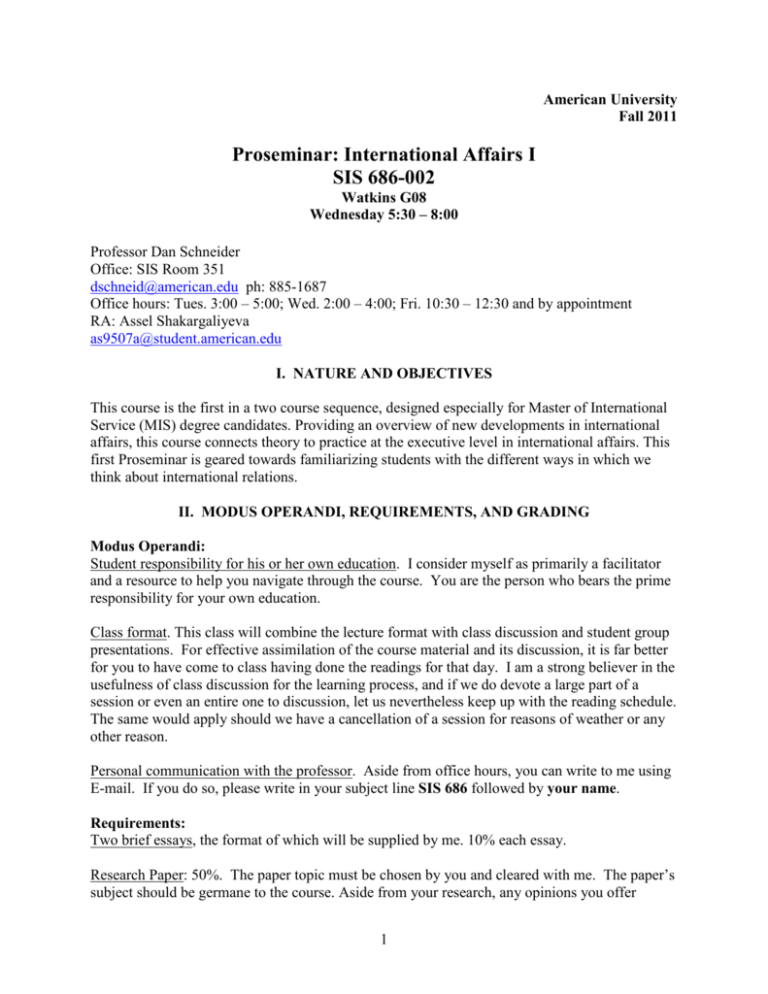
American University
Fall 2011
Proseminar: International Affairs I
SIS 686-002
Watkins G08
Wednesday 5:30 – 8:00
Professor Dan Schneider
Office: SIS Room 351
dschneid@american.edu ph: 885-1687
Office hours: Tues. 3:00 – 5:00; Wed. 2:00 – 4:00; Fri. 10:30 – 12:30 and by appointment
RA: Assel Shakargaliyeva
as9507a@student.american.edu
I. NATURE AND OBJECTIVES
This course is the first in a two course sequence, designed especially for Master of International
Service (MIS) degree candidates. Providing an overview of new developments in international
affairs, this course connects theory to practice at the executive level in international affairs. This
first Proseminar is geared towards familiarizing students with the different ways in which we
think about international relations.
II. MODUS OPERANDI, REQUIREMENTS, AND GRADING
Modus Operandi:
Student responsibility for his or her own education. I consider myself as primarily a facilitator
and a resource to help you navigate through the course. You are the person who bears the prime
responsibility for your own education.
Class format. This class will combine the lecture format with class discussion and student group
presentations. For effective assimilation of the course material and its discussion, it is far better
for you to have come to class having done the readings for that day. I am a strong believer in the
usefulness of class discussion for the learning process, and if we do devote a large part of a
session or even an entire one to discussion, let us nevertheless keep up with the reading schedule.
The same would apply should we have a cancellation of a session for reasons of weather or any
other reason.
Personal communication with the professor. Aside from office hours, you can write to me using
E-mail. If you do so, please write in your subject line SIS 686 followed by your name.
Requirements:
Two brief essays, the format of which will be supplied by me. 10% each essay.
Research Paper: 50%. The paper topic must be chosen by you and cleared with me. The paper’s
subject should be germane to the course. Aside from your research, any opinions you offer
1
should be well backed with evidence. Your bibliography should consist mainly of scholarly
books and journal articles; internet sources can be valuable, but they are frequently unreliable
from the scholarly standpoint, so you need to choose carefully. The paper must be submitted
electronically in a Microsoft Word (or compatible) format and in hard copy.
Team presentation: 20%. The format will be provided by me.
Class Participation: 10%. Attendance and class participation are not the same, although the latter
depends on the former.
Grading:
Our grading scale shall be the following:
100
SCALE
95-100
90-94
87-89
83-86
80-82
77-79
73-76
70-72
67-69
X -66
LETTER
MEANING
SCALE
A
Excellent. Demonstration of superior work in fulfillment of course
requirements.
AB+
B
Good. Good work in fulfillment of course requirements.
BC+
C
Satisfactory. Satisfactory work in fulfillment of course requirements.
CD
Poor. Assigned work is unsatisfactory or not completed.
F
Fail. Inadequate work or substantial amounts of uncompleted work.
III. ACADEMIC INTEGRITY CODE
All students are governed by AU's Academic Integrity Code. The Code details specific violations
of ethical conduct that relate to academic integrity. By registering, you have acknowledged your
awareness of the Academic Integrity Code, and you are obliged to become familiar with your
rights and responsibilities as defined by the code. All of your work (whether oral or written) in
this class is governed by the provisions of the Academic Integrity Code. Academic violations
include but are not limited to: plagiarism, inappropriate collaboration, dishonesty in
examinations whether in class or take-home, dishonesty in papers, work done for one course and
submitted to another, deliberate falsification of data, interference with other students' work, and
copyright violations. The adjudication process and possible penalties are listed in American
University's Academic Integrity Code booklet, which is also available on the American
University website. Being a member of this academic community entitles each of us to a wide
degree of freedom and the pursuit of scholarly interests; with that freedom, however, comes a
responsibility to uphold the high ethical standards of scholarly conduct.
2
IV. ADDITIONAL RESOURCES
If you experience difficulty in this course for any reason, please don’t hesitate to consult with
me. In addition to the resources of the school, a wide range of services is available to support
you in your efforts to meet the course requirements.
V. READINGS
Required:
Baylis, John, Steve Smith and Patricia Owens, editors, The Globalization of World Politics: An
Introduction to International Relations, 5th edition. Oxford, U.K.: Oxford University Press, 2011
Minogue, Kenneth, Politics: A Very Short Introduction. Oxford, U.K.: Oxford University Press,
1995, Reissued 2000.
Nye, Joseph S., Jr. and David A. Welch, Understanding Global Conflict and Cooperation: An
Introduction to Theory and History, 8th ed. New York: Pearson/Longman, 2011
Russell, Bertrand, Authority and the Individual. London and New York: Routledge, (1949) 2010
Additional required and/or recommended readings will be assigned by me.
Recommended:
Nau, Henry R., Perspectives on International Relations, 3rd ed. Washington, D.C.: CQ Press,
2012 (the second edition is also good)
VII. CLASS SCHEDULE
PART I: BACKGROUND
August 31: Introduction to course
DVD: “Commanding Heights: The Battle for the World Economy””
September 7: What do we mean by politics?
Kenneth Minogue, Politics: A Very Short Introduction (entire)
Bertrand Russell, Authority and the Individual (entire)
September 14: State and Planet – and History
Baylis, Smith & Owens
Introduction
Chapter 1: Anthony McGrew, “Globalization and global politics”
Chapter 2: David Armstrong, “The evolution of international society”
Chapter 3: Len Scott, “International history, 1900-1999”
Nye & Welch
Chapter 1: “Is There an Enduring Logic of Conflict in World Politics?”
Chapter 2: “Explaining Conflict and Cooperation: Tools and Techniques of the Trade”
3
Nau (recommended)
Introduction: “Why We Disagree About International Relations”
Chapter 1: “How to Think About International Relations”
Chapter 2: “Perspectives on World History: Change and Continuity”
Conclusion: “Applying Perspectives and Levels of Analysis: The Case of the Democratic Peace”
September 21: Realism, Liberalism, and the Problem of World Peace
Baylis, Smith & Owens
Chapter 5: Tim Dunne and Brian C. Schmidt, “Realism”
Chapter 6: Tim Dunne, “Liberalism”
Chapter 17: Christian Reus-Smit, “International law”
Nye & Welch
Chapter 3: “From Westphalia to World War I”
Chapter 4: “The Failure of Collective Security and World War II”
Nau (recommended)
Chapter 3: “World War I: World on Fire”
Chapter 4: “World War II: Why Did War Happen Again?”
September 28: Another Realism, another Liberalism, and Marxism
NOTE: first brief essay is due on this date. Paper proposal is also due on this date.
Baylis, Smith & Owens
Chapter 7: Steven L. Lamy, “Contemporary mainstream approaches: neo-realism and neoliberalism”
Chapter 8: Stephen Hobden and Richard Wyn Jones, “Marxist theories of international relations”
Nye & Welch
Chapter 5: “The Cold War”
Nau (recommended)
Chapter 5: “The Origins and End of the Cold War”
October 5: 21st Century Conflicts and Global Security
Baylis, Smith & Owens
Chapter 4: Michael Cox, “From the cold war to the war on terror”
Chapter 13: Mike Sheehan, “The changing character of war”
Chapter 14: John Baylis, “International and global security”
Chapter 19: Paul Taylor and Devon Curtis, “The United Nations”
Nye & Welch
Chapter 6: “Post-Cold War Conflict and Cooperation”
Nau (recommended)
Chapter 6: “From 11/9 to 9/11: The World of the 1990s”
4
October 12: And Yet It Moves – Globalization and Interdependence
Baylis, Smith & Owens
Chapter 15: Ngaire Woods, “International political economy in an age of globalization”
Chapter 18: Richard Little, “International regimes”
Chapter 9: Michael Barnett, “Social constructivism”
Chapter 10: Lene Hansen, “Poststructuralism”
Nye & Welch
Chapter 7: “Globalization and Interdependence”
Nau (recommended)
Chapter 8: “History of Globalization”
Chapter 9: “How Globalization Works in Practice”
October 19: Prospects for World Order
Baylis, Smith & Owens
Chapter 16: J. Ann Tickner, “Gender in world politics”
Chapter 20: Peter Willetts, “Transnational actors & international organizations in global politics”
Chapter 32: Andrew Linklater, “Globalization and the transformation of political community”
Chapter 33: Ian Clark, “Globalization and the post-cold war order”
Nye & Welch
Chapter 8: “The Information Revolution and Transnational Actors”
Chapter 9: “What Can We Expect in the Future?”
PART II: CURRENT ISSUES
October 26: Student presentations: Issues in international security
NOTE: second brief essay is due on this date.
Baylis, Smith & Owens
Chapter 22: James D. Kiras, “Terrorism and globalization”
Chapter 23: Darryl Howlett, “Nuclear proliferation”
November 2: Student presentations: Nationalism and regionalism
Baylis, Smith & Owens
Chapter 24: John Breuilly, “Nationalism”
Chapter 26: Edward Best and Thomas Christiansen, “Regionalism in international affairs”
November 9: Student presentations: Trade, finance, poverty and development
Baylis, Smith & Owens
Chapter 27: Jan Aart Scholte, “Global trade and finance”
Chapter 28: Caroline Thomas and Tony Evans, “Poverty, development, and hunger”
Nau (recommended)
Chapter 10: “Trade, Investment, and Finance: Engines of Growth”
Chapter 11: “Miracle and Missed Opportunity: Development in Asia and Latin America”
5
Chapter 12: “Foreign Aid & Domestic Governance: Development in Africa and the Middle East”
Chapter 13: “Global Inequality, Imperialism, and Injustice”
November 16: Student presentations: A new concept of human security?
Baylis, Smith & Owens
Chapter 21: John Vogler, “Environmental issues”
Chapter 29: Amitav Acharya, “Human security”
Nau (recommended)
Chapter 14: “World Environment: Population, Pollution, and Pandemics”
November 30: Student presentations: Do human rights matter?
NOTE: the research paper is due on this date.
Baylis, Smith & Owens
Chapter 30: Jack Donnelly, “Human rights”
Chapter 31: Nicholas J. Wheeler & Alex Bellamy, “Humanitarian intervention in world politics”
Nau (recommended)
Chapter 15: “Global Civil Society: Nonstate Actors and Basic Human Rights”
Chapter 16: “Global Governance: International and Regional Institutions”
December 7: Student presentations: Divided, united – how to proceed?
Baylis, Smith & Owens
Chapter 25: Simon Murden, “Culture in world affairs”
Chapter 12: Richard Shapcott, “International ethics”
6
SIS 686.002 (Fall 2011 – Prof. Dan Schneider)
Proseminar: International Affairs I
Paper Proposal: Due September 28, 2011 (or earlier)
Name:
E-mail (clearly):
Title of paper:
(Your title should be illustrative of what your paper is about. Your title can change over the course of your research)
Main research question:
(It doesn’t matter if your research question changes over the course of your investigation, but you need a clear
question to start out with.)
Why is this topic important to you? Why should it be important to anybody else?
(In other words, this should not be simply to fulfill a requirement for a course! – Make it of use to yourself and to
others! – Besides, it makes sense to choose a topic you can live with for a while.)
What steps do you propose to follow to conduct your research?
Write a table of contents, as detailed as you can make it at this time, and a schedule. This will give you a realistic
sense of what you propose to do.
Bibliography you propose to start out with:
7
(Include at least three books and five articles from scholarly journals. This is so that you can start out with some
support from previous work. It will help you think about your own paper, and even provide, eventually, a
foundation for it. You do not have to agree with the authors.
Notes:
1. Do not forget AU’s Code of Academic Integrity.
2. The paper’s extension will be no less than 15 pages of text, to which references can be added in subsequent
pages, for a maximum of 17 pages. Alternatively, the student can include footnotes in the text, and then the 17
pages can be a combination of text and notes. A bibliography is required, and the page or pages necessary to
include it will not be counted by the instructor. The margins will be one inch on all sides, and the font used will
be Times New Roman 12 point. Failure to follow these instructions may entail a loss of points.
8

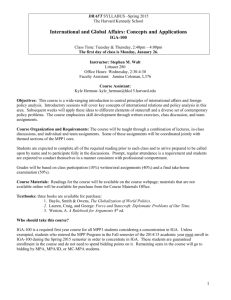
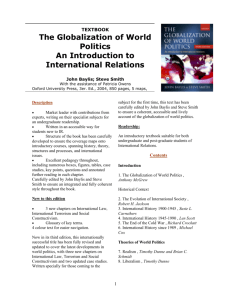
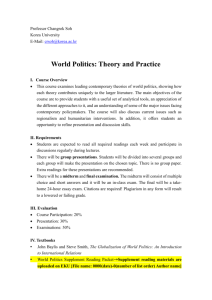
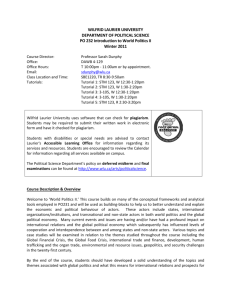
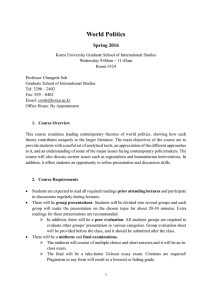
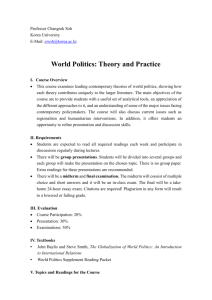
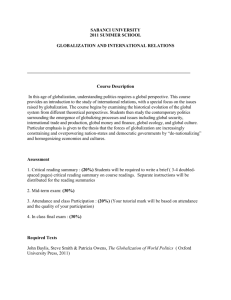
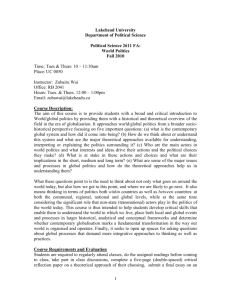
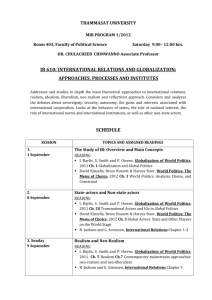
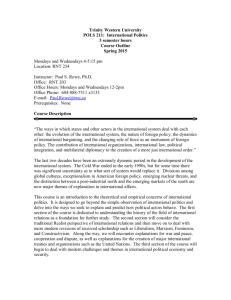
![[DISS122] Principles of International Relations Fall 2015](http://s3.studylib.net/store/data/007222312_1-399af7f667a05a0e1cbf5f3a67941f2f-300x300.png)